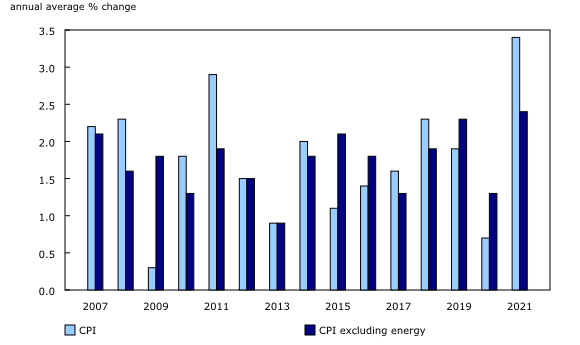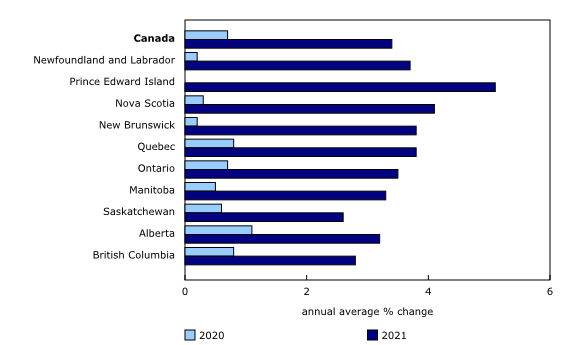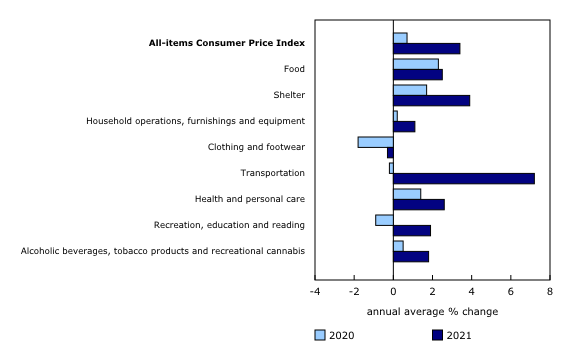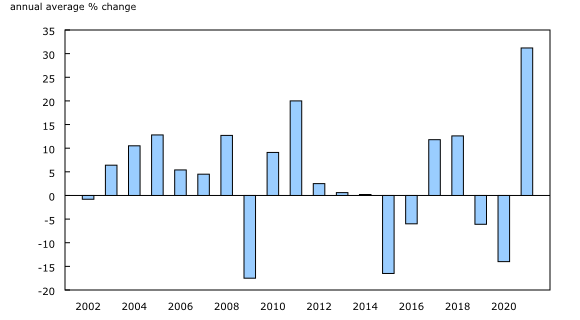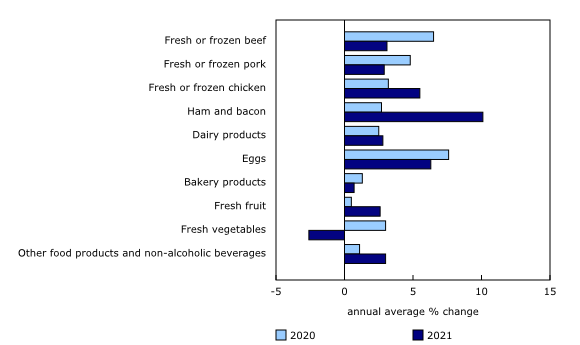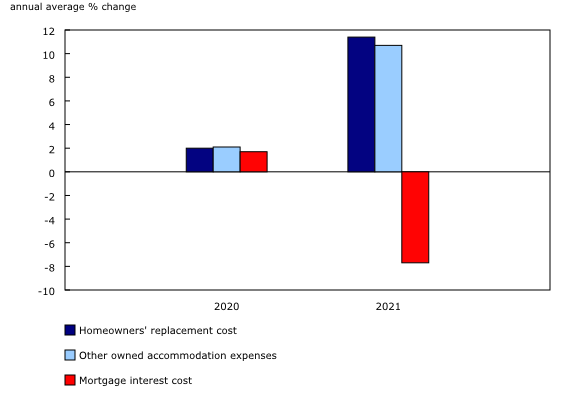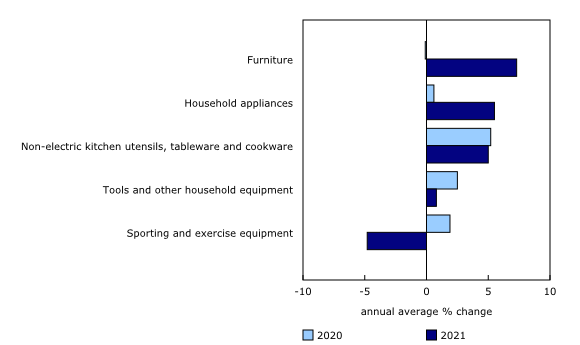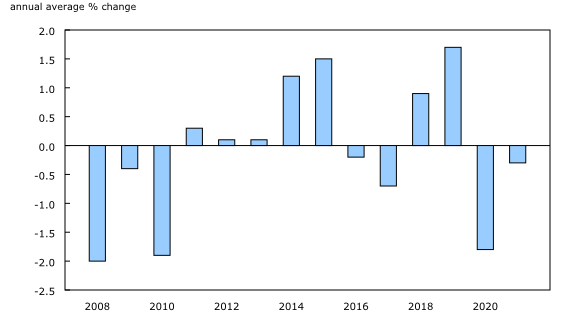Consumer Price Index: Annual review, 2021
Archived Content
Information identified as archived is provided for reference, research or recordkeeping purposes. It is not subject to the Government of Canada Web Standards and has not been altered or updated since it was archived. Please "contact us" to request a format other than those available.
Released: 2022-01-19
141.6
2021
3.4% 
(annual change)
The Consumer Price Index (CPI) rose 3.4% on an annual average basis in 2021, the fastest pace since 1991 (+5.6%), following an increase of 0.7% in 2020. Excluding energy, the annual average CPI rose 2.4% in 2021, a faster pace than in 2020 (+1.3%) and a slightly faster pace than in 2019 (+2.3%).
Highlights
On an annual average basis, the CPI rises at the fastest pace since 1991
The CPI rose 3.4% on an annual average basis in 2021, following an increase of 0.7% in 2020. This marked the fastest pace since 1991 (+5.6%).
Excluding energy, the annual average CPI grew 2.4% in 2021, a faster pace than in 2020 (+1.3%) and a slightly faster pace than in 2019 (+2.3%).
Seven of eight major CPI components up in 2021
Among the eight major components, transportation prices (+7.2%) rose at the fastest pace. Clothing and footwear prices decreased 0.3% in 2021, the lone major component to fall over the past year.
Higher prices in all provinces and territorial capital cities
Annual average prices rose at the fastest pace in Prince Edward Island (+5.1%), followed by Nova Scotia (+4.1%). Price growth among the provinces was slowest in Saskatchewan (+2.6%).
Among the territorial capital cities, annual average prices increased at the fastest pace in Whitehorse (+3.3%), followed by Yellowknife (+2.2%), while prices rose at the slowest pace in Iqaluit (+1.4%).
Prices for both goods and services rise at faster pace
Prices for goods were up 4.7% on an annual average basis in 2021, following a decline in 2020 (-0.2%).
Prices for services increased 2.3% on an annual average basis in 2021, after a gain of 1.4% in 2020.
Check out the 2021 annual review infographic
Today, Statistics Canada released the infographic Consumer Price Index: 2021 in Review, highlighting annual average consumer price inflation in Canada and the regions in 2021 and showing the noteworthy average commodity price movements in the context of the COVID-19 pandemic.
In 2021, the COVID-19 pandemic remained a key factor impacting the prices of goods and services purchased by Canadians. Inflationary pressures stemmed from a combination of widespread global supply chain constraints and pent-up consumer demand as the economy reopened. The reopening was made possible as COVID-19 vaccines became widely available and public health restrictions began to ease. Canadians were able to go out and shop, dine and travel more than in 2020. In addition, more Canadians returned to work. By September 2021, employment had recovered to pre-pandemic levels, and Canadians were consuming more, especially during months when public health measures had eased.
At the same time, the global economy grappled with significant supply chain disruptions throughout 2021, including input shortages, production bottlenecks, backlogs at key ports, higher shipping costs and delivery delays. These constraints limited the supply of goods and services.
Canadian consumers were confronted with higher prices in 2021, including for everyday necessities, such as food (+2.5%), transportation (+7.2%) and shelter (+3.9%).
While annual average growth was 3.4% in 2021, price growth differed between the first half and second half of the year. The pace of year-over-year price growth was faster in the second half of the year, especially from August to December, when price growth exceeded 4% each month. There was a consistent upward trend in the monthly CPI throughout 2021, with the lone monthly decline occurring in December 2021.
While annual average prices increased at a faster pace in every province in 2021, some regions felt the impact more than others. Atlantic Canadians faced the fastest rates of consumer price growth, as people migrated to the region from other provinces. Prince Edward Island (+5.1%) and Nova Scotia (+4.1%) recorded the highest rates of inflation, while price growth in all Atlantic provinces exceeded the national average. Canadians living in Quebec (+3.8%) and Ontario (+3.5%) also experienced price growth above the national average. Conversely, price growth in the western provinces lagged behind the national average, with Saskatchewan (+2.6%) recording the lowest inflation rate.
Base-year effects and the CPI in 2022
Looking forward, the relatively large month-over-month price movements that were observed from January 2021 to July 2021 will stop influencing the 12-month price movements in 2022. The broad increase in prices, led by prices for energy products, will have a downward impact on the year-over-year rate of consumer inflation through the first half of 2022 because higher prices from 2021 will be used as the basis for year-over-year comparisons.
This is the opposite of what occurred in the spring of 2021, when the broad decline in prices observed at the onset of the pandemic in 2020, which was led by prices for energy products and travel services, had an upward impact on the year-over-year rate of consumer inflation. For more information on the base-year effect and how it impacted the CPI in 2021, see the March 2021 and April 2021 Daily releases.
Users should consider the impact of base-year effects when interpreting the 12-month price movements in the coming months in 2022.
COVID-19 variants and the CPI
The COVID-19 pandemic has influenced Canada's CPI since the onset of the pandemic in March 2020. As the pandemic continues to evolve, the emergence of new variants, including the wide spread of the Omicron variant, may influence prices for goods and services in Canada in 2022. Statistics Canada will continue to closely monitor the evolution of COVID-19 and its potential impact on consumer price inflation.
Higher energy prices bolster headline inflation
World crude oil prices directly influence the prices Canadians pay for products such as gasoline and fuel oil and other fuels. They also indirectly influence prices for other consumer goods and services because oil is a key input into the production process. Oil prices rebounded sharply in 2021 as economies around the globe gradually reopened and consumer demand strengthened.
Canadian motorists paid 31.2% more at the pump on an annual average basis in 2021, with gasoline prices rising at the fastest pace since 1981 (+36.1%). Nova Scotians paid 39.3% more for gasoline in 2021 than they did in 2020, 8.1 percentage points more than the national average. Although gas prices in British Columbia rose at the slowest pace among the provinces, annual average prices increased 24.2%.
In addition, prices for fuel oil and other fuels rose 24.4% on an annual average basis, after falling in 2020 (-17.3%). Atlantic Canadians paid more for fuel oil and other fuels than Canadians living in other provinces, with prices rising at the fastest pace in Prince Edward Island (+46.1%). Fuel oil is more commonly used for heating homes in Atlantic Canada.
Consumers of natural gas in Canada paid on average 16.1% more than they did a year earlier, as limited supply led to higher prices. Natural gas prices rose 26.5% in Manitoba and 23.9% in Alberta compared with a year earlier.
Prices for groceries rise, but at a slower pace than in 2020
Canadians paid 2.2% more for groceries in 2021, following a 2.4% gain in 2020. Prices for important breakfast items increased in 2021: prices for eggs (+6.3%), bacon (+12.5%), bread, rolls and buns (+0.6%), and fresh fruit (+2.6%) were all higher in 2021.
Annual average dairy product prices rose 2.8% in 2021, after increasing 2.5% in 2020. This was partly driven by higher prices for butter (+6.3%). Prices for butter rose at the fastest pace in Quebec (+7.4%) and New Brunswick (+7.4%), while they increased at the slowest pace in Manitoba (+3.7%). Margarine prices (+7.4%) were also up compared with a year earlier.
Foods commonly seen at the dinner table became more expensive for Canadians, while other food prices declined compared with a year earlier. Canadians who purchased meat paid 4.3% more, on an annual average basis, in 2021. This followed a 4.5% increase in 2020, when COVID-19-induced temporary plant closures pushed meat prices up in the summer of 2020. Labour shortages, production challenges, and higher input and transportation costs, coupled with strong demand for meat in North America, contributed to the price increase in 2021.
Prices for seafood and other marine products rose 3.4% on an annual average basis, compared with a 2.1% gain a year earlier.
By contrast, Canadians saved on fresh vegetables, as prices decreased 2.6% in 2021. Tomato prices (-19.5%) fell on an annual average basis amid favourable conditions in growing regions and abundant supply. Lettuce prices declined 1.8% in 2021, after a 3.8% increase in 2020.
Shelter costs rise across Canada
In 2021, shelter costs (+3.9%) rose at the fastest pace since 2008 (+4.4%) on an annual average basis. Across the country, people sought out more living space and outdoor amenities in response to the pandemic. This change in preferences, coupled with historically low interest rates and other factors linked to the pandemic, such as higher building costs, helped push the costs of homeownership higher in Canada in 2021. Prince Edward Island (+8.5%) and Nova Scotia (+4.8%) saw shelter prices increase the most in Canada compared with a year earlier. Strong gains in shelter prices were also observed in Manitoba (+4.6%), Ontario (+4.3%) and British Columbia (+4.3%). Canadians living in Saskatchewan paid 0.8% more for shelter, the slowest rate of price growth.
Prices for accommodation rise faster for homeowners than renters
The owned accommodation price index (+4.1%) rose at a faster pace than the rented accommodation price index (+1.7%) in 2021.
The upkeep of a property, or the homeowners' replacement cost, was up 11.4% on an annual average basis, compared with a 2.0% increase in 2020. The homeowners' replacement cost, a key driver of owned accommodation price growth, is linked to the price of new homes. New home prices rose consistently throughout 2021. The homeowners' replacement cost increased the most in Manitoba (+17.6%), with Prince Edward Island (+14.7%), Quebec (+14.3%) and Nova Scotia (+12.1%) also recording strong annual average movements.
Conversely, the decline in mortgage interest cost (-7.7%) partially offset higher costs associated with owning a home, as Canadians renewed or initiated mortgages at historically low interest rates in 2021.
National rent prices increased 1.6% compared with a year earlier, after rising 1.7% in 2020. Rent prices rose faster in the Atlantic provinces of New Brunswick (+7.2%), Prince Edward Island (+6.4%) and Nova Scotia (+4.2%) than elsewhere in Canada. Rent prices increased at the slowest pace in Saskatchewan (+0.4%) and Alberta (+0.4%) compared with a year earlier.
Passenger vehicle prices rise because of semiconductor chip shortage and heightened demand
Canadians buying new passenger vehicles paid 5.1% more in 2021 compared with a year earlier, in large part because of a global shortage of semiconductor chips. This shortage limited the ability of automakers to meet heightened demand.
By contrast, the cost of insuring a passenger vehicle fell in 2021. Canadians who drive saw insurance premium prices decline by 3.4%. Drivers in British Columbia (-17.8%) saw the steepest drop in prices.
Consumers pay more for furniture and household equipment
Consumers buying big-ticket items, including furniture (+7.3%) and household equipment (+3.6%), paid more in 2021 compared with 2020. Prices for refrigerators and freezers rose 9.6% in 2021. The impact of supply chain disruptions, including limited supply, higher shipping costs and delivery delays for imported appliances, was felt by buyers of big-ticket items used in the home.
By contrast, prices for sporting and exercise equipment, including golf and home exercise equipment, fell 4.8% in 2021.
Consumers pay less for smartphones and cell phone plans
Consumers paid less for multipurpose digital devices, including smartphones, and for computer equipment, software and supplies. Prices for multipurpose digital devices fell 10.4% on an annual average basis, following a decline of 13.4% in 2020. Prices for computer equipment, software and supplies decreased 3.1% in 2021 compared with 2020 (-1.1%).
Prices for cellular services (-16.9%) fell for the second consecutive year. Cellular service providers offered more data to consumers, contributing to lower prices.
Clothing and footwear prices fall for the second consecutive year
While people enjoyed more social and work activities outside the home, clothing and footwear prices (-0.3%) were down in 2021, the lone major component to decline over the year. This was the second year in a row that prices for clothing and footwear fell, as public health measures continued to impact sales at brick-and-mortar outlets during various waves of the pandemic.
Consumers pay higher prices for services
Prices for services in Canada rose at a faster pace in 2021 (+2.3%) than in 2020 (+1.4%), partly because of higher prices for some services where physical distancing is difficult and that gradually returned during the summer months.
Prices for food purchased from restaurants and personal care services rise
Prices for food purchased from restaurants (+3.1%) and personal care services (+5.4%), including haircuts, rose as sectors where physical distancing is difficult gradually reopened in 2021. Prices increased amid capacity restrictions and higher costs incurred by firms for health and safety measures.
Travellers pay more for hotels
The desire to travel intensified in the summer months as public health measures eased and the economy gradually reopened. In 2021, travellers paid 2.2% more for accommodation on the road, including hotel rooms. Those travelling to and within British Columbia faced the fastest price growth for traveller accommodation (+5.9%). By contrast, Canadians paid less for traveller accommodation in Manitoba (-1.5%), Saskatchewan (-0.5%) or Prince Edward Island (-0.5%).
Note to readers
This release examines the percentage change between the annual average Consumer Price Index (CPI) in 2020 and 2021.
Annual average indexes are obtained by calculating the average of the 12 monthly index values over the calendar year. The annual average percentage change should not be confused with the 12-month percentage change that is published every month with the release of the CPI. Unlike the annual average change, the 12-month change compares the monthly index level with the level from the same month a year earlier.
Two ways of exploring the CPI
Visit the Consumer Price Index Portal to find all CPI data, publications, interactive tools, and announcements highlighting new products and upcoming changes to the CPI in one convenient location.
Check out the Consumer Price Index Data Visualization Tool to access current and historical CPI data in a customizable visual format.
COVID-19 and the CPI
Statistics Canada continues to monitor the impacts of COVID-19 on Canada's CPI.
Goods and services in the CPI that were not available to consumers in 2021 because of COVID-19 restrictions received special treatments, effectively removing their impact on the calculation of the monthly and annual average CPI.
When a good or service became available for consumption again, an adjustment factor was calculated to remove the impact of imputations so that the indexes reflect only observed price movements. All special treatments introduced for goods and services that were unavailable because of the COVID-19 pandemic were removed as of November 2021.
The details of the treatments from April 2020 to March 2021 are provided in technical supplements available through the Prices Analytical Series. Details and other treatment information for April 2021 and onwards are available upon request.
Statistics Canada continues to work with price experts, other national statistical organizations and partners to ensure that the data and methods used in the calculation of the official CPI are aligned with international standards and best practices.
Products
The Consumer Price Index Data Visualization Tool is available on the Statistics Canada website.
More information about the concepts and use of the Consumer Price Index is available in The Canadian Consumer Price Index Reference Paper (62-553-X).
Contact information
For more information, or to enquire about the concepts, methods or data quality of this release, contact us (toll-free 1-800-263-1136; 514-283-8300; infostats@statcan.gc.ca) or Media Relations (statcan.mediahotline-ligneinfomedias.statcan@statcan.gc.ca).
- Date modified:


